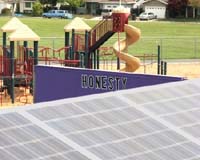 |
Boston MA (SPX) Jul 26, 2010 Every summer, thousands of people return home from work in the late afternoon and switch on their televisions, lights, and air conditioning. Their collective action temporarily increases demand for electricity, and drives up its price as utilities tap additional sources of electrical generation - typically natural-gas-fired power plants. Although this system has served well for decades, the high price of peak energy has attracted an array of new technologies - including demand response, solar power, and energy storage. All of them aim to challenge the dominance of costly natural gas "peaker" plants. But while each challenger shares a role in defraying peak demand, all must address challenges of their own before reaching their full potential, according to a new report from Lux Research. The report, titled "Who Wins the Peak? The Battle of Solar, Storage and Smart Grid to Fill Peak Demand," assesses the potential roles of demand response, solar and energy storage in satisfying peak demand. It also details the widely different costs and production profiles of each technology, and their comparative capacity factors, which is the ratio of actual power output over a given period versus total possible output during that period. "As the cost of energy storage declines, it will help make wind, solar and other intermittent renewables more viable sources of cheap dispatchable power during peak periods," said Ted Sullivan, a Senior Analyst with Lux Research and the report's lead author. "Combined with demand response, these technologies could address the top third of the peak demand curve and reduce the need to keep gas-fired turbines on standby." The report focuses on four competing technologies: solar, demand response, thermal energy storage, and compressed air energy storage. To compare the viability of each solution against conventional gas plants, Lux Research built proprietary cash flow and levelized cost of electricity (LCOE) models for each technology. To ensure accuracy, it tested its assumptions through primary interviews with technology practitioners, and extensive secondary research. Among the report's key observations: Demand response is best positioned to displace natural gas during extreme peak periods. Demand response beat out all other technologies in terms of cost, given that it requires minimal capital expenditure compared to other forms of generation. However, practical supply limits it to a 1% capacity factor, meaning that demand response cannot address the entire peak alone. Subsidized solar can outcompete natural gas, with caveats. Solar technologies present the next most attractive opportunity for peak reduction, thanks largely to subsidies. Typically mounted on rooftops in a fixed position, distributed generation solar systems have a capacity factor of roughly 23%. Ground-mounted systems equipped with tracking increase capacity factors to around 30% - maximizing their time of use revenue potential in the late afternoon peak. Although best positioned to win the peak, immaturity cripples adoption of energy storage. Energy storage technologies will be increasingly necessary to bridge the intermittency of renewables so that solar and wind can credibly supplant dispatchable natural gas generation. However, the technology's immaturity makes it a non-starter on cost and bankability, meaning that natural gas will continue to win the peak for years to come. "In order to supplant expensive natural gas peaker plants, policymakers need to better align subsidies for wind and solar with their actual cost to utilities," said Sullivan. "Although subsidies help make solar plants more economically viable, there is little incentive for utilities to install and operate them. Once installed, solar plants help satisfy peak demand, but increase system-level costs to utilities - such as the need to maintain dispatchable natural gas peaker plants in addition to solar capacity." "Who Wins the Peak? The Battle of Solar, Storage and Smart Grid to Fill Peak Demand," is part of the Lux Solar and the Lux Power Intelligence services. Clients subscribing to these services receive ongoing research on market and technology trends, continuous technology scouting reports and proprietary data points in the weekly Lux Research Solar or Power Journal, and on-demand inquiry with Lux Research analysts.
Share This Article With Planet Earth
Related Links Lux Research All About Solar Energy at SolarDaily.com
 SunEdison And Solar Liberty To Develop Solar Curriculum For Schools
SunEdison And Solar Liberty To Develop Solar Curriculum For SchoolsBuffalo, NY (SPX) Jul 23, 2010 Buffalo-based Solar Liberty and international solar developer SunEdison has announced its plans to develop a formal solar education curriculum for middle and high school students, an important step in empowering the "next generation" to lead our clean energy future. Both Solar Liberty and SunEdison are experienced in developing solar PV projects for schools. Recent projects include Solar L ... read more |
|
| The content herein, unless otherwise known to be public domain, are Copyright 1995-2010 - SpaceDaily. AFP and UPI Wire Stories are copyright Agence France-Presse and United Press International. ESA Portal Reports are copyright European Space Agency. All NASA sourced material is public domain. Additional copyrights may apply in whole or part to other bona fide parties. Advertising does not imply endorsement,agreement or approval of any opinions, statements or information provided by SpaceDaily on any Web page published or hosted by SpaceDaily. Privacy Statement |